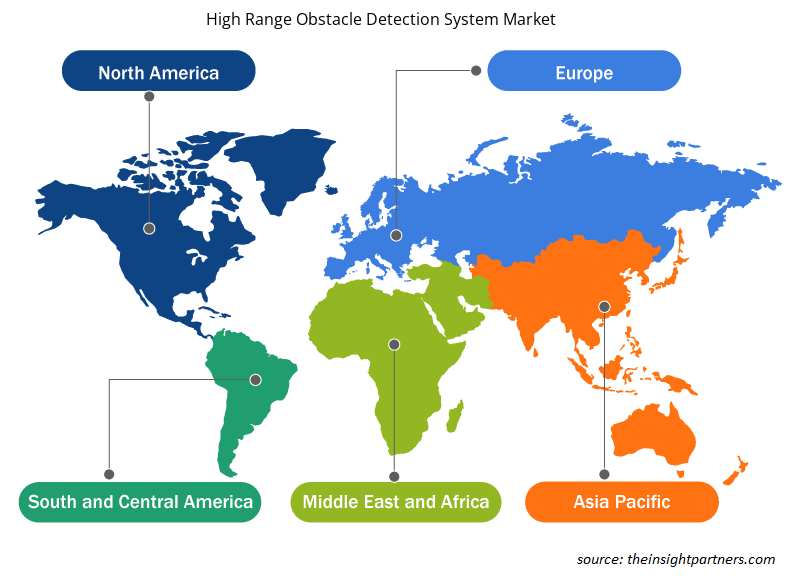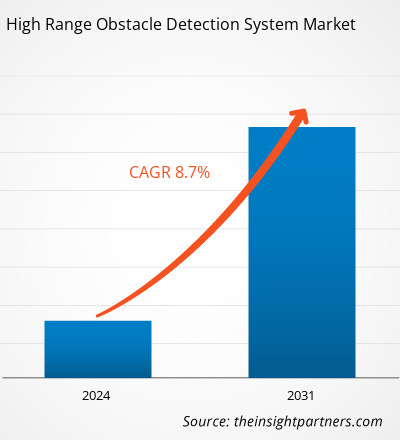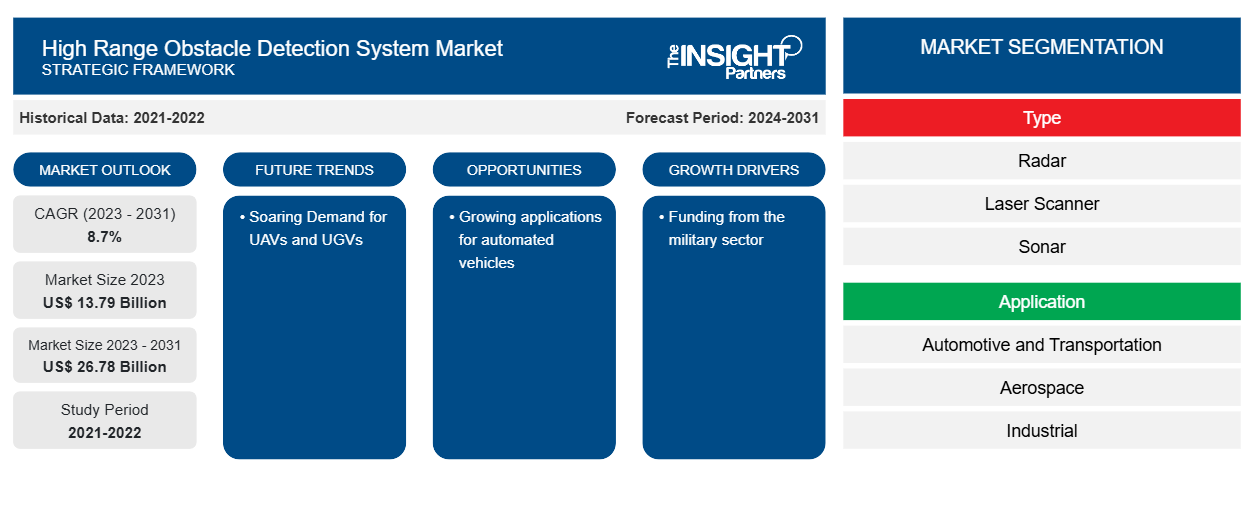고범위 장애물 감지 시스템 시장 규모는 2023년 137억 9천만 달러에서 2031년 267억 8천만 달러로 성장할 것으로 예상됩니다. 이 시장은 2023~2031년에 8.7%의 CAGR을 기록할 것으로 예상됩니다. 자동차 부문에서 효율적인 장애물 감지 시스템에 대한 수요가 증가하고 다양한 산업에서 LiDAR 기술이 도입됨에 따라 고범위 장애물 감지 시스템 시장 동향에 핵심이 될 가능성이 높습니다.
고범위 장애물 감지 시스템 시장 분석
글로벌 고범위 장애물 감지 시스템 시장은 자동차, 로봇, 항공우주, 방위 등 다양한 산업 분야에서 적용되기 때문에 빠르게 확대될 것으로 예상됩니다. 글로벌 고범위 장애물 감지 시스템 시장 성장을 견인하는 주요 요인에는 자율 주행 차 에 대한 수요 증가 와 충돌 감지에 대한 필요성 증가가 있습니다. 센서 및 관련 구성 요소의 기술적 발전은 시장 참여자에게 상당한 기회를 창출할 것으로 예상됩니다.
고범위 장애물 감지 시스템 시장 개요
신뢰할 수 있는 고범위 장애물 감지는 자율 주행차와 같은 빠르게 움직이는 안전이 중요한 플랫폼이 실시간으로 위험에 대응할 수 있도록 하는 데 필수적입니다. 고범위 장애물 감지 시스템은 나무와 건물과 같은 장애물을 멀리서 감지합니다. 레이더, 카메라, 레이저와 같은 센서를 활용하여 주변 환경의 높이와 물체를 측정하고 장애물이 감지되면 사용자에게 알립니다. 이러한 시스템은 차량 및 항공기 내비게이션, 군사 감지, 지뢰 회피 등 다양한 용도로 사용됩니다.
귀하의 요구 사항에 맞게 이 보고서를 사용자 정의하세요
이 보고서의 일부 또는 국가 수준 분석, Excel 데이터 팩을 포함하여 모든 보고서에 대한 사용자 정의를 무료로 받을 수 있으며 신생 기업 및 대학을 위한 훌륭한 혜택과 할인 혜택을 이용할 수 있습니다.
-
이 보고서의 주요 시장 동향을 알아보세요.이 무료 샘플에는 시장 동향부터 추정 및 예측까지 다양한 데이터 분석이 포함됩니다.
고범위 장애물 감지 시스템 시장 동인 및 기회
군사 부문의 자금 지원으로 시장 활성화
고범위 장애물 감지 시스템은 레이더와 비전 기술을 모두 사용하여 먼 거리에서 장애물과 위험을 감지하는 정교한 감지 시스템입니다. 드론, 지상 차량, 선박과 같은 군사적 응용 분야에서 사용됩니다. 이 시스템은 실시간으로 장애물을 감지하는 데 도움이 되는 고급 센서를 사용합니다. 이러한 고급 기술은 드론, 무인 수상 차량( USV ) 등의 효율성을 개선하는 데 도움이 됩니다. 군사 분야에서 이 기술을 사용하기 위해 시장 참여자는 군으로부터 기술적으로 진보된 솔루션을 개발하기 위한 자금을 지원받습니다. 예를 들어, 2023년 12월, KEF Robotics는 미국 국방부로부터 미 육군 고정 드론을 위한 AI 지원 장애물 감지 솔루션을 개발하기 위한 자금을 지원받았습니다.
자동차용 애플리케이션 확대
더 안전하고 효율적인 운송을 제공하므로 자동화된 차량과 자율 주행 시스템 시장이 커지고 있습니다. 자동화된 차량은 장애물 감지 시스템에 대한 수요를 창출하고, 이는 장애물을 정확하게 감지하기 위한 고범위 장애물 감지 시스템에 대한 수요를 더욱 촉진합니다. 이 솔루션을 채택하면 차량이 장애물을 빠르게 감지하고 그에 따라 반응합니다. 이 기능은 자율 주행 차량의 안전성을 향상시킵니다.
고범위 장애물 감지 시스템 시장 보고서 세분화 분석
고범위 장애물 감지 시스템 시장 분석에 기여한 주요 세그먼트는 유형과 응용 분야입니다.
- 시장은 유형에 따라 레이더, 레이저 스캐너 , 소나, LiDAR로 세분화됩니다. LiDAR 세그먼트는 가장 높은 CAGR로 성장할 것으로 예상됩니다.
- 응용 프로그램별로 시장은 자동차 및 운송, 항공우주, 산업, 해양 및 기타 응용 프로그램으로 세분화됩니다. 자동차 및 운송 부문은 2023년에 더 큰 시장 점유율을 차지했습니다.
지리적 위치별 고범위 장애물 감지 시스템 시장 점유율 분석
고범위 장애물 감지 시스템 시장 보고서의 지리적 범위는 주로 북미, 아시아 태평양, 유럽, 중동 및 아프리카, 남미/남중미의 5개 지역으로 나뉩니다.
아시아 태평양 지역은 가장 높은 CAGR로 성장할 것으로 예상됩니다. 산업용 로봇 사용이 증가함에 따라 이 지역에서 고범위 장애물 감지 시장이 성장하고 있습니다. 자율 주행차와 드론에서 고범위 장애물 감지의 광범위한 적용은 시장 성장을 더욱 촉진합니다.
고범위 장애물 감지 시스템 시장 지역 통찰력
Insight Partners의 분석가들은 예측 기간 동안 고범위 장애물 감지 시스템 시장에 영향을 미치는 지역적 추세와 요인을 철저히 설명했습니다. 이 섹션에서는 북미, 유럽, 아시아 태평양, 중동 및 아프리카, 남미 및 중미의 고범위 장애물 감지 시스템 시장 세그먼트와 지리에 대해서도 설명합니다.

- 고범위 장애물 감지 시스템 시장에 대한 지역별 데이터 얻기
고범위 장애물 감지 시스템 시장 보고서 범위
| 보고서 속성 | 세부 |
|---|---|
| 2023년 시장 규모 | 137억 9천만 달러 |
| 2031년까지 시장 규모 | 267억 8천만 달러 |
| 글로벌 CAGR (2023-2031) | 8.7% |
| 역사적 데이터 | 2021-2022 |
| 예측 기간 | 2024-2031 |
| 다루는 세그먼트 |
유형별로
|
| 포함된 지역 및 국가 |
북아메리카
|
| 시장 선도 기업 및 주요 회사 프로필 |
|
시장 참여자 밀도: 비즈니스 역학에 미치는 영향 이해
고범위 장애물 감지 시스템 시장은 소비자 선호도의 변화, 기술 발전, 제품의 이점에 대한 인식 증가와 같은 요인으로 인해 최종 사용자 수요가 증가함에 따라 빠르게 성장하고 있습니다. 수요가 증가함에 따라 기업은 제품을 확장하고, 소비자의 요구를 충족하기 위해 혁신하고, 새로운 트렌드를 활용하여 시장 성장을 더욱 촉진하고 있습니다.
시장 참여자 밀도는 특정 시장이나 산업 내에서 운영되는 회사나 기업의 분포를 말합니다. 주어진 시장 공간에 얼마나 많은 경쟁자(시장 참여자)가 존재하는지 그 규모나 전체 시장 가치에 비해 나타냅니다.
고범위 장애물 감지 시스템 시장에서 운영되는 주요 회사는 다음과 같습니다.
- BAE 시스템 주식회사
- 블릭펠트 GmbH
- 콜린스 항공우주
- 허니웰 인터내셔널 주식회사
- ifm 전자 gmbh
- 리복스
면책 조항 : 위에 나열된 회사는 어떤 특별한 순서에 따라 순위가 매겨지지 않았습니다.

- 고범위 장애물 감지 시스템 시장 주요 업체 개요를 알아보세요
고범위 장애물 감지 시스템 시장 뉴스 및 최근 개발
고범위 장애물 감지 시스템 시장
1차 및 2차 연구 이후의 질적, 양적 데이터를 수집하여 평가합니다. 여기에는 중요한 기업 간행물, 협회 데이터 및 데이터베이스가 포함됩니다. 다음은 시장의 개발 목록입니다.
- 2023년 5월, 클루지의 Bosch Engineering Center는 클루지-나포카 대중교통회사(CTP)의 일부인 트램에 Bosch가 개발한 충돌 경고 시스템인 Tram Forward Collision Warning(TFCW)을 설치했다고 발표했습니다. 이 시스템은 청각적 및 시각적 경고를 제공하여 트램 운전자를 위기 상황에서 지원하여 트램 운전자, 승객 및 기타 교통 참여자의 안전을 강화합니다. 트램 충돌 경고 시스템은 특히 교통 체증이나 가시성 저하 상황에서 선로의 장애물에 대해 적시에 경고하여 위기 상황에서 운전자를 지원합니다. 이를 통해 운전자는 사고를 피하거나 손상을 크게 줄일 수 있습니다. (보도 자료, 2023)
고범위 장애물 감지 시스템 시장 보고서 범위 및 제공물
"고범위 장애물 감지 시스템 시장 규모 및 예측(2023-2031)" 보고서는 아래 영역을 포괄하는 시장에 대한 자세한 분석을 제공합니다.
- 범위에 포함된 모든 주요 시장 세그먼트에 대한 글로벌, 지역 및 국가 수준의 시장 규모 및 예측
- 동인, 제약 및 주요 기회와 같은 시장 역학
- 주요 미래 트렌드
- 자세한 PEST/포터의 5가지 힘과 SWOT 분석
- 주요 시장 동향, 주요 업체, 규정 및 최근 시장 동향을 포괄하는 글로벌 및 지역 시장 분석
- 시장 집중도, 히트맵 분석, 유명 기업 및 최근 개발 사항을 포함하는 산업 환경 및 경쟁 분석
- 자세한 회사 프로필
- 과거 분석(2년), 기준 연도, CAGR을 포함한 예측(7년)
- PEST 및 SWOT 분석
- 시장 규모 가치/거래량 - 글로벌, 지역, 국가
- 산업 및 경쟁 환경
- Excel 데이터세트
최근 보고서
사용 후기
구매 이유
- 정보에 기반한 의사 결정
- 시장 역학 이해
- 경쟁 분석
- 고객 인사이트
- 시장 예측
- 위험 완화
- 전략 기획
- 투자 타당성 분석
- 신흥 시장 파악
- 마케팅 전략 강화
- 운영 효율성 향상
- 규제 동향에 발맞춰 대응























 무료 샘플 받기 - 고범위 장애물 감지 시스템 시장
무료 샘플 받기 - 고범위 장애물 감지 시스템 시장